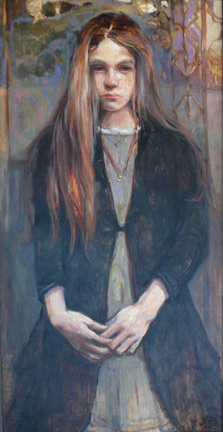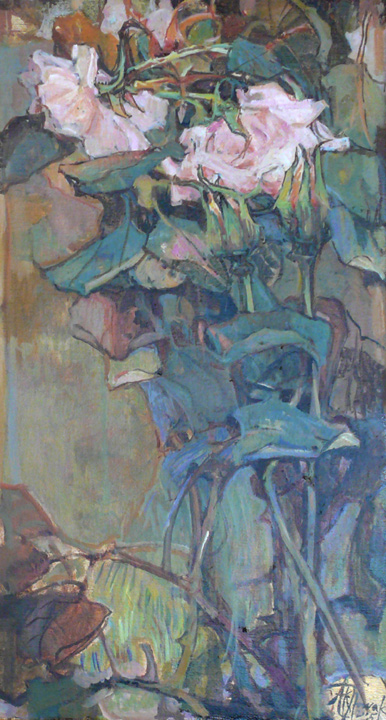Amid
all the gaudy clamor of the contemporary art scene, the Polish-born
painter Aleksandra Nowak, whose recent oils on canvas and board
are on view at CFM Gallery, 236 West 27th Street, May 2010,
is that rare discovery: an artist who still appears haunted,
even wounded, by mortal beauty. Although Nowak’s most constant
subject is the human fi gure, she invests even her occasional
landscapes and fl oral studies with an underlying sense of the
dichotomy of life and death, of ripeness and imminent decay,
that some might call morbid or decadent.
And there is no denying that a lushness verging on decadence
informs her oil “Roses I,” with its echoes of the
Viennese Succession in the fleshy pink blooms and tendril-like
stems that the artist caresses almost erotically with her brush.
The same holds true for Nowak’s “Hope,” a serenely
dreamlike pastoral landscape, in which the rhythms of the trees
mirror those of the billowing clouds, and the sun-dappled foliage
camouflages and all but consumes the small rustic dwelling near
the center of the composition with its flickering chiaroscuro.
In
this sublime bucolic salad of a picture, Nowak appears to do
nothing short of reconciling the diametrically opposed aesthetics
of Impressionism and Symbolism by virtueof imbuing a scientifically
scrupulous transcription of light and shadow with a dimension
of the intangible.
This sense of the numinous in the guise of everyday reality
is no less present in Nowak’s human subjects, which, while
they may technically belong to the genre of portraiture ––
being posed images of particular individuals rendered realistically
–– are much more than portraits in any ordinary definition
of the term.
|
|
Granted,
her skill in capturing the tones and textures of specific fabrics
in clothing or background furnishings
and
evoking a particular milieu with bravura flourishes of the brush
can often remind one of Sargent’s
society
portraits. However, Nowak is never obliged to practice flattery
in the service of vanity, since she employs her models as actors
in private dramas of her own
creation.
Indeed,
they invariably resemble characters from plays by Ibsen or Strindberg,
not only for the period quality of their costumes, but for the dramatic
resonance of their poses. For Nowak possesses the ability, especially
rare among figurative painters today, to convey complex emotions
through subtle gestures and expressions, as seen in her oil on canvas
“Claire in Summer Dress.” Here, the defiant tilt of the
dark-haired young woman’s strong chin, her aquiline nose, her
narrowed eyes, the smudge of rouge on her pale cheek, and the set
of sensual lips suggest a tempestuous nature held momentarily in
check. By contrast, the evasively unfocused eyes and impenetrable
pout of the prepubescent girl in “Promise” (who looks
as though she wishes to retreat behind her radiant curtains of hair)
reveal less about her feelings than do her boyishly oversized hands,
joined selfconsciously in front of her lower body.
Women
are the emotional protagonists of Nowak’s paintings, while
her male characters –– such as the boy sporting a derby
and dreamily touching one finger to his temple in a summer garden
in “Sunday Morning I” and the only slightly more mature
fellow seated on a stool and sporting an absurdly showy waxed mustache
in “Man, Fin De Siecle” –– appear to be aloof
dreamers, driven by grandiose schemes and ambitions outside the
domestic realm, wherein the true drama resides.
While in previous exhibitions many of Nowak’s most memorable
pictures centered on the figure of the ingenue or the youthful femme
fatale, the older, wiser female figure puts in an appearance in
more than one of her most recent visual dramas. Not only does the
artist intrepidly buck the trend, so endemic to contemporary culture,
of seducing the viewer with the sensuality of youth; she just as
daringly presents the mature subjects of both “Fortune Teller”
and “Doll Maker” in profile, foregoing even the psychological
connection that full frontal eye-contact with the viewer automatically
affords.
|
|
Yet,
even with the lower half of her face hidden by her hand, as
if by an outlaw’s mask, “Fortune Teller” mesmerizes
one with the witch-like power of a knowingglance askance.
And the noble brow, high cheekbones, and prominent nose of
“Doll Maker,” posed like a voo doo crone with some
of her progeny visible on a shelf in the background, synthesizes
the facial characteristics of two formidable woman artists:
the painter Georgia O’Keeffe and the photographer Annie
Leibovitz. As if to confi rm this writer’s conviction
that there truly is an underlying narrative in which all of
Nowak’s characters participate –– as well as
to suggest, perhaps, the symbolic role of the artist as manipulating
deity –– effigies resembling those on the shelf
behind the doll maker take center stage in Nowak’s oil
“Night Watch.”
Ostensibly,
this could be a simple picture of dolls clustered together
on a sofa in a darkened livingroom. But as with all of Nowak’s
paintings, it suggests more than meets the eye. The most prominent
doll, the one in the frilly dress with ribbons in her hair,
could suggest some descendent of the dwarfi sh little girl
in Rembrandt’s famous masterpiece of the same name. For
while the clown doll behind her and the stuffed animal at
her feet appear to be asleep, her vigilance suggests that
she may at any second rouse the others and lead them in some
magical procession like “The Dance of the Wooden Soldiers”
–– or indeed, the military procession in Rembrandt’s
picture! “Night Watch,” like another oil entitled
“The Masquerade,” depicting an array of clowns and
other carnivalesque figures dissolving in luminous oil glazes,
suggests a possible departure for this talented artist.
|
Could
it be that under the auspices of CFM gallery director Neil Zukerman,
who continues in his new Chelsea location the tradition he established
over several years in Soho of featuring the very best contemporary
exemplars of Surrealist and Symbolist inspired art, the paintings
of Aleksandra Nowak aretaking a turn for the phantasmagorical?
|
––
Ed McCormack
Gallery & Studio Magainze, Vol. 12, No. 4. April/May 2010
|
|
|
Exquisite
technique coupled with artistic vision defines our user-friendly
presentation of figurative fine art paintings, sculptures
and original graphics. Contemporary symbolism at its apex
in the traditions of Bosch, the Italian Renaissance, Art Deco,
Art Nouveau, the Viennese and German Secession and the symbolist
movements with an edge of surrealism.
|
|






















